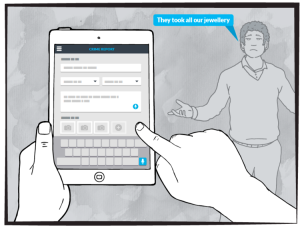

View Case Study
Implementing a customer-centred digital strategy, including redesigning and modernising how The Metropolitan Police reports crimes.
Leading global service design consultancy, WAE, delivers client transformation by putting customers at the heart of their clients’ businesses. Since 2013, WAE has worked with The Metropolitan Police (The Met) to develop and implement a customer-centred digital strategy. This includes developing strategic and tactical work that examines and designs new tools and channels of communication for both police officers and the public. Working in partnership with The Met Mobility team, WAE developed a pilot system to enhance three key areas of The Met’s Crime Reporting Information System (CRIS) using an iPad mini – enabling officers to quickly and efficiently report crimes and missing persons, collect evidence and record witness statements.
With a clear vision to minimise paperwork, improve the flow of information and help officers make urgent decisions, WAE implemented collaborative, user-centred methodologies to create an end-to-end mobile service. Workshops with Met stakeholders provided key insights to crystallise the vision, develop storyboards, design the interface and compile a best practice toolkit. WAE was able to plan the tactical integration of a mobile device to address some of CRIS’ user experience shortfalls with storyboards describing a future strategic vision of how a front-line officer would use an iPad mini on location.
Mobile CRIS and eStatements were the first two Apps to be provisioned to officers for Mobile use via iPad. A trial of the system ran in the Borough of Hammersmith and Fulham and the Mobility Pilot went live late July 2014. CRIS system now has more than 500 users and in the space of six months, 14,100 crime reports were created via iPad, more than 60,500 crime reports were retrieved to officers devices and in August 2015, 90.28% of crime reports created by 'Response Officers' were created using iPad. Since July 2014 there have been more than 17,500 eStatements produced and it counts with more than 500 users.
- Why this project is worthy of a UX Award:
Traditionally, crime scene reporting processes have been long-winded and complex, with front line officers having to gather various pieces of physical information and paperwork that then had to be taken back to the station and entered into the CRIS system. By creating a mobile system that has all these processes in a single device, WAE is streamlining the work of front line officers making it easier and faster from start to finish.
The challenge of this project was to effectively create a mobile system that was useful for The Met. In order to understand the current CRIS system, and also how police officers and staff use it, WAE ran a number of workshops with over 40 front line police staff. Additionally WAE held more than 80 stakeholder interviews.
During the workshops WAE was able to go through the processes, workflows and methodologies that The Met were using and really understand where problems exist by mapping the current journey and user experience. The existing processes were extremely cumbersome to use and time consuming. The system was very much designed for a desktop environment rather than mobile. Through this process, the underlying problems were identified - this being both a problem with the system, as well as the workflows and the user interface.
The project was undertaken in less than six weeks to rectify the user experience issues. The insight gained from the workshops and interviews provided a good base to improve the way front line officers using the system were interfacing with it. From workshops and interviews, WAE created visionary storyboards that illustrated the future state of policing
The mobile system now allows officers to record statements, capture evidence, both photographic and voice on the device. This information is then stored on the device and at the end of each crime scene investigation officers package the information up, digitally sign it, and then it is ready to be passed onto the justice system. - Submitted By: WAE
- Client Name:
See More 2015 Submissions >>